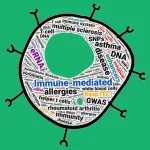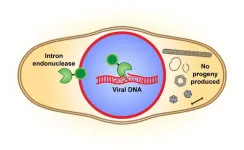(Press-News.org) Pseudomonas aeruginosa – an environmental bacteria that can cause devastating multidrug-resistant infections, particularly in people with underlying lung conditions – evolved rapidly and then spread globally over the last 200 years, probably driven by changes in human behaviour, a new study has found.
P. aeruginosa is responsible for over 500,000 deaths per year around the world, of which over 300,000 are associated with antimicrobial resistance (AMR). People with conditions such as COPD (smoking-related lung damage), cystic fibrosis (CF), and non-CF bronchiectasis, are particularly susceptible.
How P. aeruginosa evolved from an environmental organism into a specialised human pathogen was not previously known. To investigate this, an international team led by scientists at the University of Cambridge examined DNA data from almost 10,000 samples taken from infected individuals, animals, and environments around the world. Their results are published today in Science
By mapping the data, the team was able to create phylogenetic trees – ‘family trees’ – that show how the bacteria from the samples are related to each other. Remarkably, they found that almost seven in ten infections are caused by just 21 genetic clones, or ‘branches’ of the family tree, that have rapidly evolved (by acquiring new genes from neighbouring bacteria) and then spread globally over the last 200 years. This spread occurred most likely as a result of people beginning to live in densely-populated areas, where air pollution made our lungs more susceptible to infection and where there were more opportunities for infections to spread.
These epidemic clones have an intrinsic preference for infecting particular types of patients, with some favouring CF patients and other non-CF individuals. It turns out that the bacteria can exploit a previously unknown immune defect in people with CF, allowing them to survive within macrophages. Macrophages are cells that ‘eat’ invading organisms, breaking them down and preventing the infection from spreading. But a previously-unknown flaw in the immune systems of CF patients means that once the macrophage ‘swallows’ P. aeruginosa, it is unable to get rid of it.
Having infected the lungs, these bacteria then evolve in different ways to become even more specialised for a particular lung environment. The result is that certain clones can be transmitted within CF patients and other clones within non-CF patients, but almost never between CF and non-CF patient groups.
Professor Andres Floto, Director of the UK Cystic Fibrosis Innovation Hub at the University of Cambridge and Royal Papworth Hospital NHS Foundation Trust, and senior author of the study said: “Our research on Pseudomonas has taught us new things about the biology of cystic fibrosis and revealed important ways we might be able to improve immunity against invading bacteria in this and potentially other conditions.
“From a clinical perspective, this study has revealed important information about Pseudomonas. The focus has always been on how easily this infection can spread between CF patients, but we’ve shown that it can spread with worrying ease between other patients, too. This has very important consequences for infection control in hospitals, where it’s not uncommon for an infected individual to be on an open ward with someone potentially very vulnerable.
“We are incredibly lucky at Royal Papworth Hospital where we have single rooms and have developed and evaluated a new air-handling system to reduce the amount of airborne bacteria and protect all patients.”
Dr Aaron Weimann from the Victor Phillip Dahdaleh Heart & Lung Research Institute at the University of Cambridge, and first author on the study, said: “It’s remarkable to see the speed with which these bacteria evolve and can become epidemic and how they can specialise for a particular lung environment. We really need systematic, pro-active screening of all at risk patient groups to detect and hopefully prevent the emergence of more epidemic clones.”
The research was funded by Wellcome and the UK Cystic Fibrosis Trust.
Reference
Weimann, A et al. Evolution and host-specific adaptation of Pseudomonas aeruginosa. Science; 4 July 2024; DOI: 10.1126/science.adi0908
END
Scientists map how deadly bacteria evolved to become epidemic
Pseudomonas aeruginosa found to exploit immune defect to persist in cystic fibrosis patients
2024-07-04
ELSE PRESS RELEASES FROM THIS DATE:
Biodegradable biomass-based aerogel for sustainable radiative cooling
2024-07-04
An aerogel made from gelatin and DNA surpasses 100% solar reflectance, yielding exceptional radiative cooling, a new study reports. It is also biodegradable. The novel approach paves the way for high-performance next-generation radiative cooling materials, promoting environmentally friendly advancements in the field. Sustainable, energy-efficient, and environmentally conscious cooling technologies are crucial for adapting to our rapidly warming world. Compared to traditional refrigeration systems, passive radiative cooling technologies consume less energy and emit fewer greenhouse gasses, making them ...
New brain-to-nerve signaling mechanism reveals potential path to migraine pain
2024-07-04
The rapid influx of cerebral spinal fluid (CSF) and protein solutes released during cortical spreading depression (CSD) in the brain activates neurons to trigger aural migraine headaches, according to a new mouse study. The findings identify a novel non-synaptic signaling mechanism between the brain and peripheral sensory system important for migraine. They also suggest potential pharmacological targets for treating the painful disorder. Migraine with aura, or an aural migraine, is a distinct headache disorder that can include sensory disturbances, such as hearing- or vision-related symptoms that precede onset of ...
Federal grid reforms alone are not enough to solve clean energy interconnection problem
2024-07-04
Although energy production from wind and solar has grown rapidly in the United States, its integration into the national electric grid has been impeded by poor grid interconnection policies, leaving thousands of new facilities for generating renewable energy waiting to be connected to the grid. In a Policy Forum, Les Armstrong and colleagues highlight the interconnection problem and discuss whether federal grid policy reforms alone are enough to address it. Armstrong et al. argue that while the US Federal Energy Regulatory Commission’s (FERC) recent orders to improve this bottleneck are a step in the right direction, fundamental issues remain unaddressed. In the ...
Uncovering “blockbuster T cells” in the gut wins NOSTER & Science Microbiome Prize
2024-07-04
In the gut, dozens of strains of bacteria exert different effects on the immune system that in turn impact our health – fending off pathogens, helping digest food and maybe even influencing behavior. But pinpointing which bacteria exert which effects has been challenging. Better understanding this process could lead to a powerful way to treat a host of diseases. For developing a method by which to zero in on individual gut bacterium’s impacts on T cells, Kazuki Nagashima, a senior research scientist at Stanford University, is the winner of this year’s NOSTER & Science Microbiome ...
Study reveals brain fluid dynamics as key to migraine mysteries, new therapies
2024-07-04
New research describes for the first time how a spreading wave of disruption and the flow of fluid in the brain triggers headaches, detailing the connection between the neurological symptoms associated with aura and the migraine that follows. The study also identifies new proteins that could be responsible for headaches and may serve as foundation for new migraine drugs.
“In this study, we describe the interaction between the central and peripheral nervous system brought about by increased concentrations of proteins released ...
Scientists discover new T cells and genes related to immune disorders
2024-07-04
Researchers led by Yasuhiro Murakawa at the RIKEN Center for Integrative Medical Sciences (IMS) and Kyoto University in Japan and IFOM ETS in Italy have discovered several rare types of helper T cells that are associated with immune disorders such as multiple sclerosis, rheumatoid arthritis, and even asthma. Published July 4 in Science, the discoveries were made possible by a newly developed technology they call ReapTEC, which identified genetic enhancers in rare T cell subtypes that are linked to specific immune ...
The dawn of the Antarctic ice sheets
2024-07-04
In recent years global warming has left its mark on the Antarctic ice sheets. The "eternal" ice in Antarctica is melting faster than previously assumed, particularly in West Antarctica more than East Antarctica. The root for this could lie in its formation, as an international research team led by the Alfred Wegener Institute has now discovered: sediment samples from drill cores combined with complex climate and ice-sheet modelling show that permanent glaciation of Antarctica began around 34 million years ago – ...
Not so selfish after all: Viruses use freeloading genes as weapons
2024-07-04
Curious bits of DNA tucked inside genomes across all kingdoms of life historically have been disregarded since they don’t seem to have a role to play in the competition for survival. Or so researchers thought.
These DNA pieces came to be known as “selfish genetic elements” because they exist, as far as scientists could tell, to simply reproduce and propagate themselves, without any benefit to their host organisms. They were seen as genetic hitchhikers that have been inconsequentially passed ...
Researchers identify unknown signalling pathway in the brain responsible for migraine with aura
2024-07-04
A previously unknown mechanism by which proteins from the brain are carried to a particular group of sensory nerves causes migraine attacks, a new study shows. This may pave the way for new treatments for migraine and other types of headaches.
More than 800,000 Danes suffer from migraines – a condition characterised by severe headache in one side of the head. In around a fourth of all migraine patients, headache attacks are preceded by aura – symptoms from the brain such as temporary visual or sensory disturbances preceding the migraine attack by 5-60 minutes.
While ...
Music: Song melodies have become simpler since 1950
2024-07-04
The complexity of the melodies of the most popular songs each year in the USA — according to the Billboard year-end singles charts — has decreased since 1950, a study published in Scientific Reports suggests.
Madeline Hamilton and Marcus Pearce analysed the most prominent melodies (usually the vocal melody) of songs that reached the top five positions of the US Billboard year-end singles music charts each year between 1950 and 2022. They found that the complexity of song rhythms and pitch arrangements decreased over this period as the average number of notes ...
LAST 30 PRESS RELEASES:
Tracing the quick synthesis of an industrially important catalyst
New software sheds light on cancer’s hidden genetic networks
UT Health San Antonio awarded $3 million in CPRIT grants to bolster cancer research and prevention efforts in South Texas
Third symposium spotlights global challenge of new contaminants in China’s fight against pollution
From straw to soil harmony: International team reveals how biochar supercharges carbon-smart farming
Myeloma: How AI is redrawing the map of cancer care
Manhattan E. Charurat, Ph.D., MHS invested as the Homer and Martha Gudelsky Distinguished Professor in Medicine at the University of Maryland School of Medicine
Insilico Medicine’s Pharma.AI Q4 Winter Launch Recap: Revolutionizing drug discovery with cutting-edge AI innovations, accelerating the path to pharmaceutical superintelligence
Nanoplastics have diet-dependent impacts on digestive system health
Brain neuron death occurs throughout life and increases with age, a natural human protein drug may halt neuron death in Alzheimer’s disease
SPIE and CLP announce the recipients of the 2025 Advanced Photonics Young Innovator Award
Lessons from the Caldor Fire’s Christmas Valley ‘Miracle’
Ant societies rose by trading individual protection for collective power
Research reveals how ancient viral DNA shapes early embryonic development
A molecular gatekeeper that controls protein synthesis
New ‘cloaking device’ concept to shield sensitive tech from magnetic fields
Researchers show impact of mountain building and climate change on alpine biodiversity
Study models the transition from Neanderthals to modern humans in Europe
University of Phoenix College of Doctoral Studies releases white paper on AI-driven skilling to reduce burnout and restore worker autonomy
AIs fail at the game of visual “telephone”
The levers for a sustainable food system
Potential changes in US homelessness by ending federal support for housing first programs
Vulnerability of large language models to prompt injection when providing medical advice
Researchers develop new system for high-energy-density, long-life, multi-electron transfer bromine-based flow batteries
Ending federal support for housing first programs could increase U.S. homelessness by 5% in one year, new JAMA study finds
New research uncovers molecular ‘safety switch’ shielding cancers from immune attack
Bacteria resisting viral infection can still sink carbon to ocean floor
Younger biological age may increase depression risk in older women during COVID-19
Bharat Innovates 2026 National Basecamp Showcases India’s Most Promising Deep-Tech Ventures
Here’s what determines whether your income level rises or falls
[Press-News.org] Scientists map how deadly bacteria evolved to become epidemicPseudomonas aeruginosa found to exploit immune defect to persist in cystic fibrosis patients


